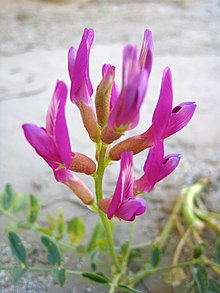Astracantha
| Astragalus | |
|---|---|
 |
|
| A. lentiginosus | |
| Scientific classification | |
| Kingdom: | Plantae |
| (unranked): | Angiosperms |
| (unranked): | Eudicots |
| (unranked): | Rosids |
| Order: | Fabales |
| Family: | Fabaceae |
| Subfamily: | Faboideae |
| Tribe: | Galegeae |
| Subtribe: | Astragalinae |
| Genus: |
Astragalus L. |
| Type species | |
|
Astragalus onobrychis L. |
|
| Synonyms | |
|
|
Astragalus is a large genus of about 3,000 species of herbs and small shrubs, belonging to the legume family Fabaceae and the subfamily Faboideae. It is the largest genus of plants in terms of described species. The genus is native to temperate regions of the Northern Hemisphere. Common names include milkvetch (most species), locoweed (in North America, some species) and goat's-thorn (A. gummifer, A. tragacanthus). Some pale-flowered vetches are similar in appearance, but vetches are more vine-like.
Astragalus species are used as food plants by the larvae of some Lepidoptera species including many case-bearing moths of the genus Coleophora: C. cartilaginella, C. colutella, C. euryaula, and C. onobrychiella feed exclusively on Astragalus, C. astragalella and C. gallipennella feed exclusively on the species Astragalus glycyphyllos, and C. hippodromica is limited to Astragalus gombo.
The natural gum tragacanth is made from several species of Astragalus occurring in the Middle East, including A. adscendens, A. gummifer, A. brachycalyx, and A. tragacanthus. Also Astragalus propinquus (syn. A. membranaceus) has a history of use as a herbal medicine used in systems of traditional Chinese medicine and Persian medicine. In traditional Chinese medicine A. membranaceus has been used to reinforce qi and strengthen the superficial resistance, and promote the discharge of pus and the growth of new tissue.
...
Wikipedia
